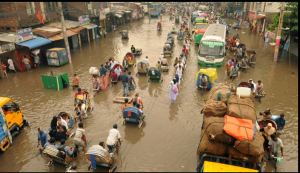River otters, lichen on trees and coral in oceans are not just beautiful to look at, they tell us something important about the environment around them.
The return of otters to a river can point to water becoming cleaner, lichens typically appear when the air is clear and free of pollution, while if corals – part of the large animal group known gloriously as cnidarians – bleach and die it can be a sign of oceans warming. Famously, Cuban tree frogs are thought to be under threat due to climate change. Collectively such organisms are known as ‘indicator species.’
You wouldn’t think that humanity could fall into that group. We have an extraordinary ability to inhabit everywhere from the most polluted inner cities, choking mines and factory sites, to the sweetest meadow and untouched island paradise. We can make camp in harsh sub-zero Arctic conditions and live as nomads in the sweltering desert.
But, look more closely at the fate of particular groups of people, and you can tell an awful lot about what is happening to certain key environments and the planet more generally. From endangered tropical forests in Brazil and Liberia, to contested tracts of fertile land under threat of being ‘grabbed’ across Asia, people defending the environment and land rights are increasingly under attack and being killed.
Thinking of such environmental defenders just as an ‘indicator species’ is too technical and reductive. But as people under ever more violent threat, who find themselves on the front line of humanity’s transgression of planetary boundaries, they have become bellwethers, those who reveal the existence of a trend.
Competition for access to natural resources is intensifying. Logging and mining concessions, land grabs for industrial scale palm oil plantations, all these deals pitch powerful vested interests against the livelihoods of communities and the long-term health of the environment.
This plays out against a backdrop of the still unquestioned pursuit of economic growth and rising consumption in rich countries, together with extreme global inequality. Humanity in the meantime is crossing the threshold of several vital ecological life-support functions.
As a result, more and more people find themselves like border guards at our planetary boundaries, defending their environment from corporate or state abuse and unsustainable exploitation.
In the decade between 2002 and 2013 there were 908 known killings of people across 35 countries resulting from their work on environment and land issues. The worst year on record was 2012, but numbers for 2013 are expected to rise due to a time lag in data.
These figures, though, are just the visible tip of a larger veiled mountain of harassment and intimidation. Because of the failure of the international system to properly recognise, record and report on the plight of environmental defenders, these known deaths – on a par with the number of journalists killed as a result of their work over the same period – are almost certainly a significant underestimate.
For example, unrecorded killings are highly likely in African countries such as Nigeria, the Democratic Republic of Congo, Central African Republic and Zimbabwe that are enduring resource-fuelled unrest, but information is almost impossible to gain without detailed field investigations.
So, all around the world, an increasing number of individuals and communities operate like guardians, look-outs, watchers, pioneers, messengers on the edge of our planetary boundaries – feeling the brunt of resource competition and providing the human face of the consequences of global overreach. Their example challenges us to accept ecological limits and devise a new economic compact for how we can all survive and prosper by sharing a finite world.
The year of the worst recorded killings of environmental defenders – 2012 – also saw a conference to mark the 20th anniversary of the Rio Earth Summit. The day the conference closed, two campaigners – Almir Nogueira de Amorim and João Luiz Telles Penetra – fighting on behalf of Rio’s fishing communities against the expansion of oil operations were abducted nearby in Rio de Janeiro state and later found executed.
The killers of environmental defenders enjoy almost complete impunity. Only 10 perpetrators, about 1% of the overall incidence of known killings, are known to have been tried, convicted and punished between 2002 and 2013.
Later this year in December government officials from around the world will gather for the next climate change talks in Lima, Peru. Without urgent action, as they struggle towards a paper agreement on progress, the murder and intimidation of ordinary people actually defending the environment and land will continue outside the conference halls largely ignored.
With crushing irony, environmental defenders who find themselves in conflict with powerful vested interests get depicted as enemies of development. Yet a model of economic development that undermines planetary life-support systems and kills and intimidates those who would protect them, cannot really be called ‘development’ at all.
As long as human progress in lower income nations is based on the exploitation of their natural resources to feed relentless over-consumption elsewhere, this problem will remain and worsen. New approaches to development must begin with communities first and foremost being able to manage and benefit, securely and in environmentally resilient ways, from their own natural resources.
In the meantime we need action to recognise and protect environmental defenders. In finding the frontline of their struggles globally, we will be drawing a map of planetary boundaries. For the sake of our own collective survival, we must then work out how to stay the right side of the lines.
-Guardian




